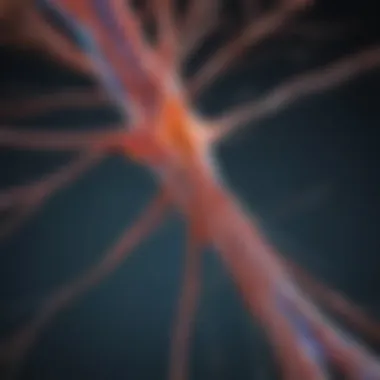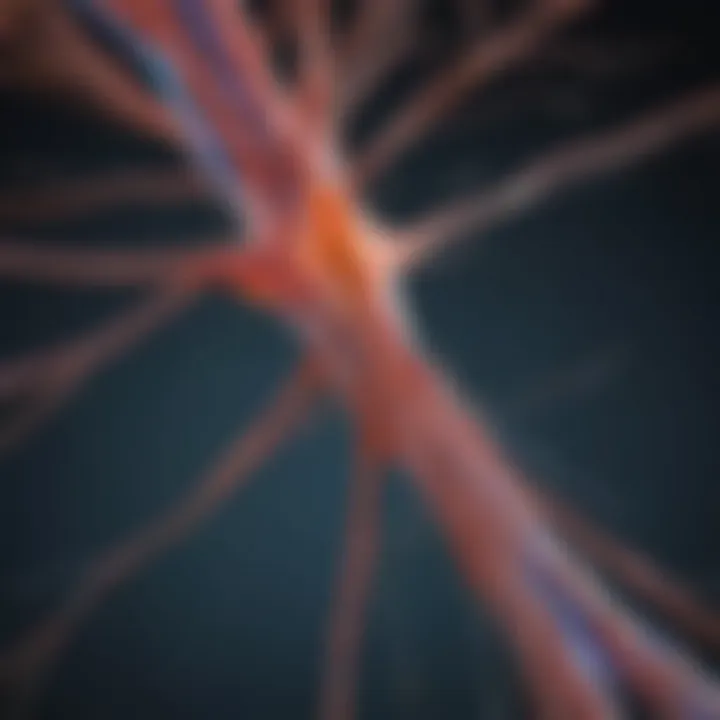Understanding Polyneuritis Symptoms and Management


Intro
Polyneuritis, commonly known as peripheral neuropathy, is an intricate condition that affects multiple peripheral nerves at once. Understanding its symptoms is crucial for accurate diagnosis and effective management. This article seeks to explore the nuanced manifestations of polyneuritis symptoms. It will shed light on various aspects, including sensory and motor dysfunctions, which are vital for healthcare professionals and researchers.
Article Overview
Purpose of the Article
The primary purpose of this article is to dissect the symptoms associated with polyneuritis. By doing so, it aims to provide a clearer understanding of how these symptoms impact patients' lives. Clarity in symptom recognition allows for better strategies in treatment and management. Furthermore, it is essential for researchers and medical professionals to comprehend these nuances to advance their knowledge and contribute to improved patient care.
Relevance to Multiple Disciplines
Polyneuritis holds significance across various fields, including neurology, rehabilitation, and pain management. Its study requires collaboration among healthcare teams, researchers, and educators. This multidisciplinary approach fosters a comprehensive understanding of nerve disorders and their implications on patient well-being.
Research Background
Historical Context
The understanding of polyneuritis has evolved significantly over the decades. Initially, it was often misdiagnosed due to overlapping symptoms with other conditions. As research advanced, clearer criteria for diagnosis and treatment emerged. Historical figures in neurology laid the groundwork for present knowledge and management approaches.
Key Concepts and Definitions
To effectively discuss polyneuritis symptoms, it is essential to define key concepts:
- Peripheral nerves: These are nerves located outside the brain and spinal cord, responsible for transmitting signals between the central nervous system and the rest of the body.
- Inflammation: This refers to the body's response to injury or infection, often causing pain and dysfunction in affected areas.
- Motor dysfunction: This involves impairments in muscle control and movement.
- Sensory dysfunction: This includes abnormalities in the body’s ability to feel sensations.
"A thorough understanding of polyneuritis symptoms can significantly enhance the quality of life for those affected by this condition."
"A thorough understanding of polyneuritis symptoms can significantly enhance the quality of life for those affected by this condition."
In summary, recognizing the symptoms of polyneuritis is crucial for accurate diagnosis and potential treatment options. Following this foundation, the article will explore specific symptoms and their implications in detail.
Intro to Polyneuritis
Polyneuritis represents a significant medical concern due to its impact on multiple peripheral nerves. Understanding this condition is critical for healthcare professionals, students, and researchers who aim to develop effective diagnostic and management strategies. The symptoms associated with polyneuritis can vary widely, which necessitates a solid grasp of its manifestations. The complexity of this disorder makes it essential to systematically explore the causes and implications for patient well-being. Through thorough understanding, clinicians can provide better care and support to those affected.
Defining Polyneuritis
Polyneuritis, commonly known as peripheral neuropathy, refers to the simultaneous inflammation of numerous peripheral nerves. This condition leads to a spectrum of symptoms that can interfere with daily life. The peripheral nervous system, which includes all nerves outside the brain and spinal cord, plays a crucial role in transmitting signals to and from the central nervous system. In polyneuritis, the inflammation can arise from various factors such as infectious agents, toxins, autoimmune responses, or metabolic disturbances.
The clinical presentation of polyneuritis often includes a combination of sensory and motor dysfunction. Sensory symptoms typically involve pain, tingling, or a loss of sensation, while motor symptoms might result in muscle weakness and atrophy. Autonomic symptoms, although less common, can also emerge, affecting various body systems and leading to further complications. The multifaceted nature of polyneuritis makes it a challenging condition to diagnose and treat.
Historical Context of Polyneuritis
The understanding of polyneuritis has evolved over time. Initially, various forms of neuropathy were poorly documented, and many patients suffered from misdiagnosis or inadequate treatment. Historical texts reveal a growing awareness of peripheral nerve disorders, particularly in the context of infectious diseases such as diphtheria, which was recognized for causing nerve damage as far back as the 19th century.
With advancements in medical knowledge and technology, the diagnostic criteria and treatment options have improved. Modern research has provided deeper insights into the pathophysiology of polyneuritis. The appreciation of autoimmune disorders and their relation to nerve inflammation has also expanded. Historical views have shaped contemporary approaches, emphasizing the need for rigorous clinical evaluation and ongoing research into effective therapeutic strategies.
The journey from early observations to modern-day understandings underscores the importance of continuous learning in the medical field. By examining the history of polyneuritis, professionals can appreciate how past experiences inform current practices and inspire future research directions.
Causes of Polyneuritis
Understanding the causes of polyneuritis is essential for a comprehensive view of this condition. Identifying the underlying factors enables healthcare professionals to develop effective management strategies and tailor treatment to the individual's needs. Causes of polyneuritis can range from infections to autoimmune disorders. Each cause presents unique challenges for diagnosis and treatment, highlighting the complexity of the condition.
Infectious Agents
Infectious agents are known to be significant contributors to polyneuritis. Various pathogens, including viruses, bacteria, and parasites, can lead to nerve inflammation. For instance, the HIV virus and Lyme disease, caused by the Borrelia burgdorferi bacterium, have been documented to cause symptoms of polyneuritis. Moreover, certain viral infections such as cytomegalovirus can also play a role in the development of peripheral nerve issues. These agents often provoke immune responses that can damage peripheral nerves, leading to sensory and motor dysfunction.
Toxins and Chemicals
Exposure to certain toxins and chemicals can also initiate polyneuritis. Environmental elements, such as heavy metals like lead and mercury, have been implicated. Additionally, some medications can cause nerve damage as a side effect. Chemotherapy drugs, for example, often have neurotoxic effects. Understanding the role of these toxins is crucial in both preventive and therapeutic contexts, as minimizing exposure may reduce the incidence of polyneuritis in susceptible populations.
Autoimmune Disorders
Autoimmune disorders represent another prevalent cause of polyneuritis. In these conditions, the immune system mistakenly attacks the body’s own tissues, leading to inflammation of peripheral nerves. Examples include Guillain-Barré syndrome and Chronic Inflammatory Demyelinating Polyneuropathy (CIDP). Patients with autoimmune origins of polyneuritis may display heightened symptoms, which require careful monitoring and tailored interventions that address the immune system’s role in nerve damage.
Metabolic Disorders
Metabolic disorders also contribute to the onset of polyneuritis. Conditions such as diabetes and alcoholism lead to nutrient deficiencies that affect nerve health. Diabetic neuropathy is one of the most common forms, where high blood sugar levels cause nerve damage over time. Similarly, chronic alcohol consumption can lead to vitamin B deficiency, resulting in peripheral nerve issues. Recognizing these metabolic factors allows healthcare providers to address the fundamental issues and implement lifestyle changes or treatments that can significantly impact symptom management.
Symptoms Overview
The symptoms of polyneuritis play a critical role in understanding the overall impact of this condition on individuals. Recognizing these symptoms is essential for timely diagnosis and effective management. This section delves into the specific symptoms associated with polyneuritis, categorizing them into sensory, motor, and autonomic manifestations. Each category encompasses various symptoms that contribute uniquely to the patient's experience. Understanding these symptoms not only helps in distinguishing polyneuritis from other nerve disorders but also assists healthcare professionals in determining the appropriate interventions.


Sensory Symptoms
Sensory symptoms often present as the first signs of polyneuritis. These symptoms can significantly affect the quality of life. They include:
Neuropathic Pain
Neuropathic pain is a prominent feature of polyneuritis. It results from damage to the peripheral nerves, causing pain that is often described as sharp, burning, or tingling. This type of pain is different from nociceptive pain, which results from tissue injury. Neuropathic pain can be debilitating, leading to difficulty in daily activities. It is a key characteristic because its management is crucial for improving patient comfort and functioning. The challenge with neuropathic pain lies in its resistance to standard painkillers, making it necessary to explore other treatment modalities.
Altered Sensation
Altered sensation refers to changes in the way a person perceives stimuli. This can manifest as increased sensitivity, decreased sensitivity, or a complete loss of sensation. Patients may experience sensations that are uncomfortable or painful, even with non-painful stimuli. The recognition of altered sensation is important in diagnosing polyneuritis. This symptom highlights how nerve damage can distort normal sensory processing, which impacts the patient's ability to interact with their environment.
Hypersensitivity
Hypersensitivity involves an exaggerated response to stimuli. Patients with polyneuritis may find everyday sensations overwhelmingly intense. This condition can lead to a heightened perception of touch, temperature, or pressure. Understanding hypersensitivity is essential because it influences patient care and therapeutic approaches. Additionally, it is indicative of the nervous system's altered state due to polyneuritis.
Motor Symptoms
Motor symptoms of polyneuritis can hinder physical movement and coordination. They are largely attributed to impairments in the motor nerves. Key motor symptoms include:
Muscle Weakness
Muscle weakness is a central motor symptom in polyneuritis. It can range from mild weakness to significant impairment that affects mobility and independence. Patients may struggle to perform tasks that require strength, such as lifting objects or climbing stairs. The presence of muscle weakness signals the need for early intervention and rehabilitation, which can aid in recovery and maintaining functionality.
Atrophy
Atrophy refers to the wasting away of muscle tissue. In polyneuritis, atrophy occurs due to disuse or nerve damage. This weakness can signal the severity of the disease. Tracking muscle atrophy is vital for healthcare providers to determine the extent of nerve damage and to tailor rehabilitation strategies effectively.
Fasciculations
Fasciculations are involuntary muscle twitches that can be observed in patients with polyneuritis. They are often harmless but can be unsettling. When they occur, they indicate anomalies within the motor neuron pathways. Although less common, their presence can provide significant diagnostic information, aiding in the understanding of the underlying nerve condition.
Autonomic Symptoms
Autonomic symptoms result from nerve damage affecting involuntary bodily functions. These symptoms can be complex and varied. Significant autonomic symptoms include:
Cardiovascular Dysregulation
Cardiovascular dysregulation can manifest as irregular heart rates, blood pressure fluctuations, or vasomotor instability. This symptom affects how the body responds to stress and regulates blood flow. Monitoring these changes is crucial as they can lead to serious health complications. Understanding this aspect offers insights into the systemic implications of polyneuritis on a patient's overall health.
Gastrointestinal Issues
Patients with polyneuritis may also experience gastrointestinal symptoms. These can include difficulty swallowing, constipation, or diarrhea. The interplay between nerve function and digestive health illustrates the extensive influence that nerve damage can have. Addressing gastrointestinal issues is vital in promoting overall well-being in affected individuals.
Urogenital Dysfunction
Urogenital dysfunction involves problems associated with bladder or sexual functions. This symptom can greatly affect quality of life and lead to psychological distress. Understanding these implications underscores the comprehensive challenges faced by patients with polyneuritis, necessitating holistic treatment approaches.
"Understanding the symptoms of polyneuritis not only helps in diagnosis but also guides effective management strategies, ultimately aiming to improve patient outcomes and quality of life."
"Understanding the symptoms of polyneuritis not only helps in diagnosis but also guides effective management strategies, ultimately aiming to improve patient outcomes and quality of life."
The array of symptoms associated with polyneuritis is vast and significantly impacts patient experience and health care approaches. Accurate recognition and understanding of these symptoms are crucial for effective intervention and management.
Clinical Presentation
The clinical presentation of polyneuritis is crucial in comprehending the full extent of this condition. Understanding how symptoms manifest aids healthcare professionals in making accurate diagnoses. Early recognition of symptoms like sensory or motor dysfunction is vital for initiating treatment. Knowledge of the clinical presentation offers insights into not only the individual experience of the patient but also the broader implications for public health.
As polyneuritis typically presents with a variety of symptoms, understanding these aspects can enhance management strategies and improve overall patient outcomes.
Early Symptoms
Early symptoms of polyneuritis can vary widely among individuals. Common initial experiences may include:
- Tingling or Numbness: Many patients report sensations often described as a pins-and-needles feeling. These tactile disturbances usually occur in the extremities.
- Weakness: Reduced muscle strength, especially in the hands and feet, may be an early indicator. Patients might find it hard to grip objects or perform tasks requiring fine motor skills.
- Hypersensitivity: Some individuals experience increased sensitivity to touch. Activities like wearing shoes or even light pressure can become uncomfortable.
Recognizing these early signs can lead to prompt intervention. This can significantly impact the disease's trajectory and management.
Progression of Symptoms
As polyneuritis advances, the nature of symptoms typically evolves. Understanding this progression is vital for effective monitoring and treatment planning. Possible developments include:
- Increased Pain: As the condition worsens, neuropathic pain may intensify, often becoming more frequent and debilitating.
- Severe Muscle Weakness: There could be substantial difficulty in walking or standing, making mobility increasingly challenging.
- Atrophy: Over time, muscle wasting can occur due to prolonged inactivity or severe weakness, leading to visible changes in the physical structure of limbs.
- Autonomic Symptoms: Patients may start to experience issues related to involuntary functions, such as problems regulating blood pressure or digestive issues.


The progression of symptoms can impact the overall quality of life. Regular assessments help in planning appropriate therapeutic approaches and necessary adjustments in management tactics.
Understanding the clinical presentation and evolution of symptoms in polyneuritis adds layers to the clinical picture, allowing for both targeted and comprehensive intervention strategies.
Understanding the clinical presentation and evolution of symptoms in polyneuritis adds layers to the clinical picture, allowing for both targeted and comprehensive intervention strategies.
Diagnosis of Polyneuritis
The diagnosis of polyneuritis is a critical step in understanding the condition and its impacts on patients. Accurate diagnosis enables healthcare providers to devise tailored management strategies. With a range of presenting symptoms that can overlap with other neurological disorders, a robust diagnostic framework is essential. Here, we explore the different aspects that contribute to a comprehensive diagnosis, emphasizing the relevance to effective treatment and patient outcomes.
Clinical Evaluation
Clinical evaluation is the first line of diagnostic approach in polyneuritis. Physicians typically start with a detailed medical history and a thorough physical examination. This assessment aims to identify the pattern of symptoms observed, such as sensory disturbances or motor deficits. It is crucial to differentiate polyneuritis from other similar conditions, as misdiagnosis can lead to inadequate treatment.
During the examination, doctors may look for signs of muscle weakness, atrophy, or abnormal reflex responses. Observing these physical manifestations can guide the clinician towards a more accurate diagnosis. Additionally, understanding the patient's medical history, including previous illnesses and exposure to potential toxins, contributes significantly to the evaluation process.
Electrophysiological Studies
Electrophysiological studies play an important role in diagnosing polyneuritis. These tests help assess the electrical activity of nerves and muscles. Common exams include nerve conduction studies and electromyography (EMG).
- Nerve conduction studies measure how fast electrical signals move through nerves. In polyneuritis, these signals may slow down or show decreased amplitudes, indicating nerve damage.
- EMG evaluates the electrical activity in muscles. It can reveal abnormalities in muscle response, providing further evidence of peripheral nerve involvement.
These studies are indispensable in confirming a diagnosis of polyneuritis and distinguishing it from other neurological conditions, such as myopathy or radiculopathy.
Laboratory Tests
Laboratory tests are also vital for diagnosing polyneuritis. These tests can help identify underlying causes that may contribute to the condition. Common tests include:
- Blood tests to check for signs of diabetes, vitamin deficiencies, or autoimmune diseases.
- Lumbar puncture may be performed to analyze cerebrospinal fluid for signs of infection or inflammation.
- Imaging studies, such as MRI, can help visualize the nervous system and rule out other structural abnormalities.
Management Strategies
Effective management strategies are integral to addressing polyneuritis due to the multifaceted nature of its symptoms. The importance of these strategies lies not only in alleviating symptoms but also in improving the overall quality of life for affected individuals. Proper management can help restore some functional ability and prevent further deterioration of the nerves.
Pharmacological Interventions
Pain Management
Pain management forms a cornerstone of treatment for patients with polyneuritis. This aspect addresses neuropathic pain, which is often severe and can be debilitating. The focus here is to utilize various analgesics effectively, which may include over-the-counter medications such as acetaminophen or prescription medications like opioids for more severe pain.
The key characteristic of pain management is its immediate effect on enhancing patient comfort. Given the persistent nature of neuropathic pain, ensuring effective pain relief is critical. Unique features of this approach include the use of tailored medication regimens that take into account personal response and side effects, which can vary significantly between individuals.
However, there are disadvantages, such as the potential for dependence on stronger pain medications and the side effects related to these drugs. This necessitates careful monitoring and adjustments by healthcare providers.
Neuropathic Agents
Neuropathic agents, which often include drugs like gabapentin and pregabalin, specifically target nerve pain at the source. Their role in managing symptoms of polyneuritis is crucial, as they can help modify the way nerves send pain signals to the brain.
A primary feature of neuropathic agents is their ability to reduce the overall sensation of pain without affecting the body's other sensory pathways. This makes them a popular choice. Their unique advantage lies in their dual function: they can alleviate pain while possibly promoting nerve healing.
Nevertheless, these agents can present disadvantages like dizziness or sedation, which may affect the patient's daily activities. Close monitoring is essential to assess their effectiveness and adjust dosages accordingly.
Immunosuppressants
Immunosuppressants like corticosteroids and azathioprine can be beneficial for patients with certain autoimmune forms of polyneuritis. They work by reducing inflammation surrounding the nerves, thus alleviating symptoms. This approach can slow progression in cases where the immune system plays a significant role.
The distinctive feature of immunosuppressants is their ability to suppress immune responses that attack peripheral nerves. Their use can be a lifesaver in preventing further nerve damage. Moreover, they have been shown to improve nerve regeneration over time, which can lead to better functional recovery.
That said, the long-term use of immunosuppressants comes with potential side effects, including increased risk of infections and other complications. Regular assessments and a careful approach are necessary to mitigate these risks.
Physical Therapies
Strength Training
Strength training is vital in the management framework for polyneuritis. This aspect aims to rebuild muscle strength that can be lost due to nerve damage. Engaging in personalized strength training regimens encourages muscle recovery and helps maintain mobility.
A key characteristic of strength training is its capacity to fortify both muscle and skeletal function. This is critical in preventing atrophy and maintaining stability. A unique feature is its adaptability; programs can be tailored to each individual's capabilities, thus maximizing benefits.
However, a disadvantage is the potential for injury if exercises are not performed correctly or if individuals push beyond their limits. Consultation with trained physical therapists is essential for safe implementation.
Balance Exercises
Balance exercises are essential for enhancing coordination and preventing falls, which individuals with polyneuritis are particularly prone to due to muscle weakness or sensory loss. These exercises focus on improving stability and proprioception, empowering patients to navigate their environments more safely.


The uniqueness of balance exercises lies in their ability to address specific deficits that arise from nerve damage. They serve as a proactive measure to mitigate the risk of injuries.
One disadvantage is that they may require more time to demonstrate noticeable improvement in balance control, and patient adherence can vary due to fatigue or frustration with progress.
Nutritional Support
Nutritional support plays a significant role in the comprehensive management of polyneuritis. It addresses the need for essential nutrients that promote nerve health. This includes B vitamins, such as B12, which are critical for nerve repair and function.
Nutritional support aims to provide the body with tools necessary for healing. A unique feature is the potential association between specific dietary patterns and symptom alleviation.
However, the challenge includes ensuring that patients consistently adhere to advised dietary changes, which can be difficult for some individuals amidst other health concerns.
In summary, integrating pharmacological, physical, and nutritional management strategies is essential in dealing with the complexities of polyneuritis symptoms. Each component contributes to creating a multifaceted approach aimed at achieving improved patient outcomes.
In summary, integrating pharmacological, physical, and nutritional management strategies is essential in dealing with the complexities of polyneuritis symptoms. Each component contributes to creating a multifaceted approach aimed at achieving improved patient outcomes.
Prognosis
The prognosis of polyneuritis holds significant importance in understanding the overall impact of this condition on patient well-being. It is crucial to evaluate prognosis as it provides insights into recovery potential, long-term disability, and the effects treatment strategies may have. Knowing the expected course of the disease can help clinicians tailor personalized management plans, ultimately improving patient outcomes.
One aspect of prognosis involves assessing specific factors influencing recovery. Understanding the nuances of these factors can aid healthcare providers in predicting how well a patient may respond to treatment. Factors can vary widely, and often include:
- Underlying Causes: Identifying the underlying cause of polyneuritis plays a critical role. If a systemic infection or toxic exposure is treatable, early intervention may facilitate complete recovery.
- Patient’s Overall Health: The general health status of the patient significantly affects recovery. Pre-existing conditions like diabetes or cardiovascular disease can hinder healing processes.
- Timeliness of Diagnosis: Early diagnosis and intervention can lead to better outcomes. Delays in treatment can lead to irreversible nerve damage, impacting prognosis.
- Adherence to Treatment Plans: Patients who effectively follow their treatment regimens often experience more favorable results. This adherence can improve symptom management and enhance quality of life.
Long-Term Outcomes
Long-term outcomes for individuals with polyneuritis can vary markedly based on the nature of the nerve damage and how effectively the condition is managed over time. Many patients experience a spectrum of recovery, which can be categorized as follows:
- Complete Recovery: In some cases, particularly where the causative factor is successfully treated, patients may achieve full recovery with no residual symptoms.
- Partial Recovery: Others may notice improvement but experience lingering effects, such as mild pain or muscle weakness, impacting daily activities.
- Chronic Symptoms: Some individuals may struggle with chronic symptoms, leading to persistent discomfort or disability. This often necessitates ongoing treatment and support.
- Psychosocial Impacts: It’s also essential to recognize that long-term outcomes are not solely physiological. The psychosocial aspects, such as coping mechanisms and support networks, can significantly influence quality of life.
"The prognosis can evolve over time, and it is important to remain adaptable in treatment strategies, aligning with patient progress and needs."
"The prognosis can evolve over time, and it is important to remain adaptable in treatment strategies, aligning with patient progress and needs."
In summary, a nuanced understanding of prognosis regarding polyneuritis enables healthcare professionals to provide informed guidance to patients. It stresses the necessity of early intervention and ongoing assessment to optimize recovery and manage long-term effects effectively.
Research Developments
Understanding polyneuritis, particularly its symptoms, relies heavily on ongoing research. It is essential to examine recent advancements in the field as they contribute significantly to both clinical practice and the overall grasp of the condition. Research developments are paramount not only because they help in clarifying the pathophysiology of polyneuritis but also because they open doors to improved treatment options and management strategies. They enhance patient awareness and assist healthcare professionals in making informed decisions.
Current Trends in Polyneuritis Research
Recent studies have increasingly focused on the molecular mechanisms behind polyneuritis. Innovative techniques such as genomics and proteomics are being utilized to identify biomarkers that can provide deeper insights into the condition. This is especially relevant as it can lead to early detection and a better understanding of disease progression. Also, researchers are investigating the role of environmental factors and underlying genetic predispositions that can contribute to polyneuritis onset.
Moreover, there are promising trends in the realm of regenerative medicine. Stem cell therapy and neurotrophic factors are being explored as potential innovations to restore nerve function. These avenues aim to enhance the body's natural healing processes and mitigate the symptoms associated with polyneuritis. Understanding these trends can help in the development of targeted therapies that can genuinely improve a patient’s quality of life.
Innovative Treatment Approaches
As research evolves, innovative treatment approaches are emerging that have potential efficacy in managing polyneuritis symptoms. One promising strategy is the use of novel pharmaceutical agents that specifically target neuropathic pain pathways. Existing medications are being reformulated to increase effectiveness while reducing side effects, specifically focusing on neuropathic agents such as pregabalin and duloxetine.
In addition, interdisciplinary approaches incorporating physical rehabilitation have gained traction. Therapies that focus not just on pain relief but also on restoring mobility and functionality are being emphasized. Techniques such as electrical stimulation and tailored exercise programs are being tested, showing encouraging results for some patients.
As new research illuminates the complexities of polyneuritis, a more personalized approach to treatment is emerging.
As new research illuminates the complexities of polyneuritis, a more personalized approach to treatment is emerging.
Nutritional interventions also play a significant role. Nutraceuticals are or being utilized more frequently, offering a non-pharmacological pathway to improve nerve health and overall well-being. Vitamins like B12 have shown promise in the rehabilitation of peripheral nerve functions. By integrating clinical findings with practical treatments, the management strategies for polyneuritis are becoming more holistic.
Overall, keeping abreast of these research developments is crucial for healthcare providers and patients alike. This knowledge facilitates a better understanding of the disease, improves symptom management, and significantly enhances the focus on individualized care.
End
In concluding this exploration of polyneuritis symptoms, it is necessary to recognize the profound impact this condition has on individuals. The symptoms stemming from polyneuritis can significantly alter a person's quality of life. Accurate diagnosis and management are imperative. Each symptom, whether of sensory, motor, or autonomic origin, guides healthcare professionals in determining the extent of nerve involvement and the necessary interventions.
In essence, recognizing the intricate symptomatology of polyneuritis is vital. It influences treatment pathways and management strategies, ultimately aiming to enhance the well-being of those affected.
Summary of Key Points
- Symptoms are Varied: Polyneuritis encompasses a range of symptoms affecting sensory, motor, and autonomic functions.
- Importance of Early Diagnosis: Early recognition of symptoms can facilitate timely intervention leading to better outcomes.
- Patient Education: A well-informed patient is crucial for effective management and communication.
- Interdisciplinary approach: Collaborative efforts among healthcare professionals are essential for comprehensive care.
Future Directions in Research
Research on polyneuritis continues to evolve and may focus on:
- Genetic Studies: Understanding genetic predispositions to polyneuritis could reveal new targets for intervention.
- Biomarker Identification: Discovering specific biomarkers might enhance diagnostic accuracy and treatment personalization.
- Novel Therapeutics: Investigation into innovative therapies that go beyond traditional pharmacological options could greatly impact management efficacy.
- Longitudinal Studies: Tracking patients over extended periods may provide insights into disease progression and long-term outcomes.
"Research plays a crucial role in enhancing our understanding and treatment of complex conditions like polyneuritis."
"Research plays a crucial role in enhancing our understanding and treatment of complex conditions like polyneuritis."
Through these avenues, the field can better address the complexities of polyneuritis, ultimately seeking to improve patients' quality of life.



